Abstract
Cats in which the coronary and allied chemoreflexes could not be obtained with small intravenous doses of 5-hydroxytryptamine were insensitive also to phenyldiguanide. In cats which responded to phenyldiguanide with reflex falls of blood pressure and heart rate, abolished by vagotomy, the effects of graded doses (5 to 150 μg./kg.) of phenyldiguanide bore a striking resemblance to those produced initially by 5-hydroxytryptamine in somewhat smaller doses. Differences in the cardiovascular responses to the two drugs are attributed to additional (non-reflex) actions of 5-hydroxytryptamine. The reflex actions of both drugs were blocked reversibly also by 2-naphthylguanidine (500 μg.). Certain other drugs (bufotenine, procaine, S-decylisothiourea) antagonized the depressor action of phenyldiguanide as well as the reflex depressor action of 5-hydroxytryptamine. Like 5-hydroxytryptamine, phenyldiguanide and certain other amidine derivatives caused pain when applied to the base of blisters in human subjects. Unlike 5-hydroxytryptamine, phenyldiguanide did not constrict perfused rat blood vessels or increase the tone of the rat fundal strip preparation of Vane (1957). Phenyldiguanide did not affect the sensitivity of these smooth muscle preparations to 5-hydroxytryptamine, but other amidine derivatives proved to be moderately strong antagonists of the vasoconstrictor actions of 5-hydroxytryptamine and of adrenaline. Unlike 5-hydroxytryptamine, phenyldiguanide did not produce gastric haemorrhage in the mouse. Phenyldiguanide did not prolong chloral hydrate sleeping time in mice by the same mechanism as did 5-hydroxytryptamine. Phenyldiguanide was not highly toxic to mice (LD50 being 240 mg./kg.). It is concluded that phenyldiguanide and certain other amidine derivatives act on sensory receptors which respond to 5-hydroxytryptamine, but that they show little pharmacological resemblance to 5-hydroxytryptamine in other respects.
Full text
PDF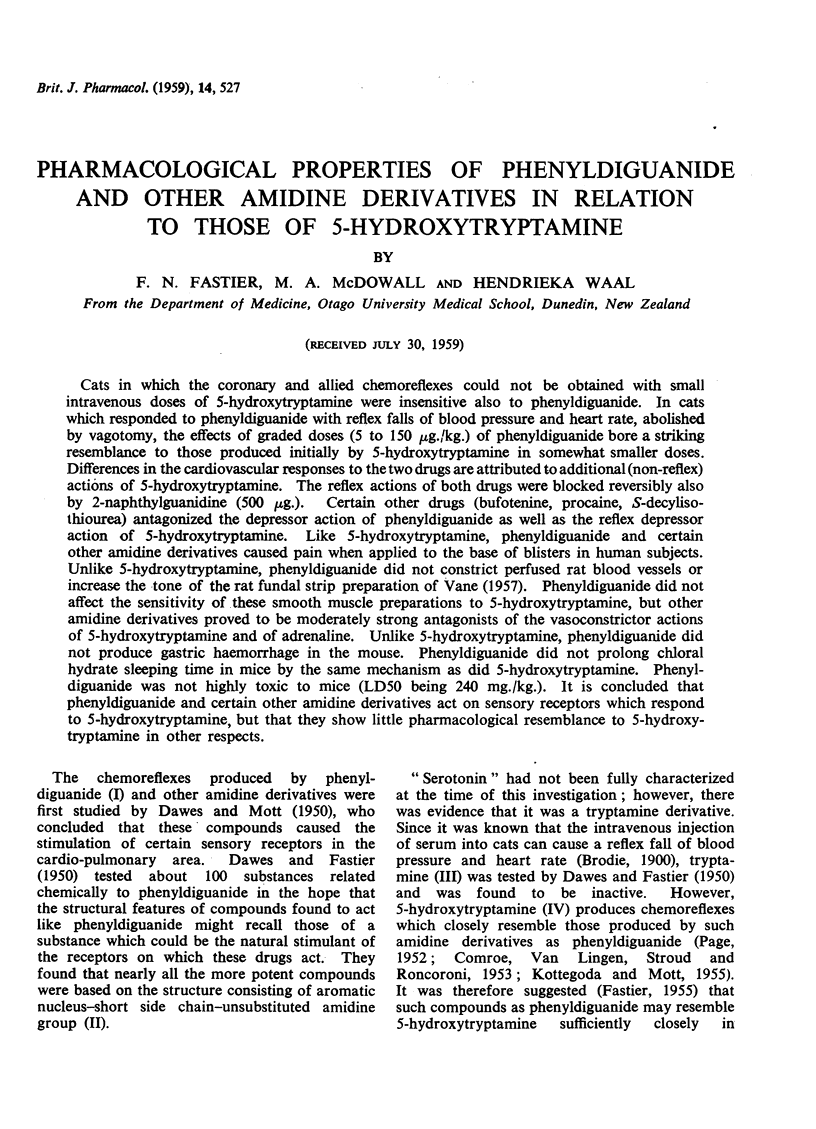

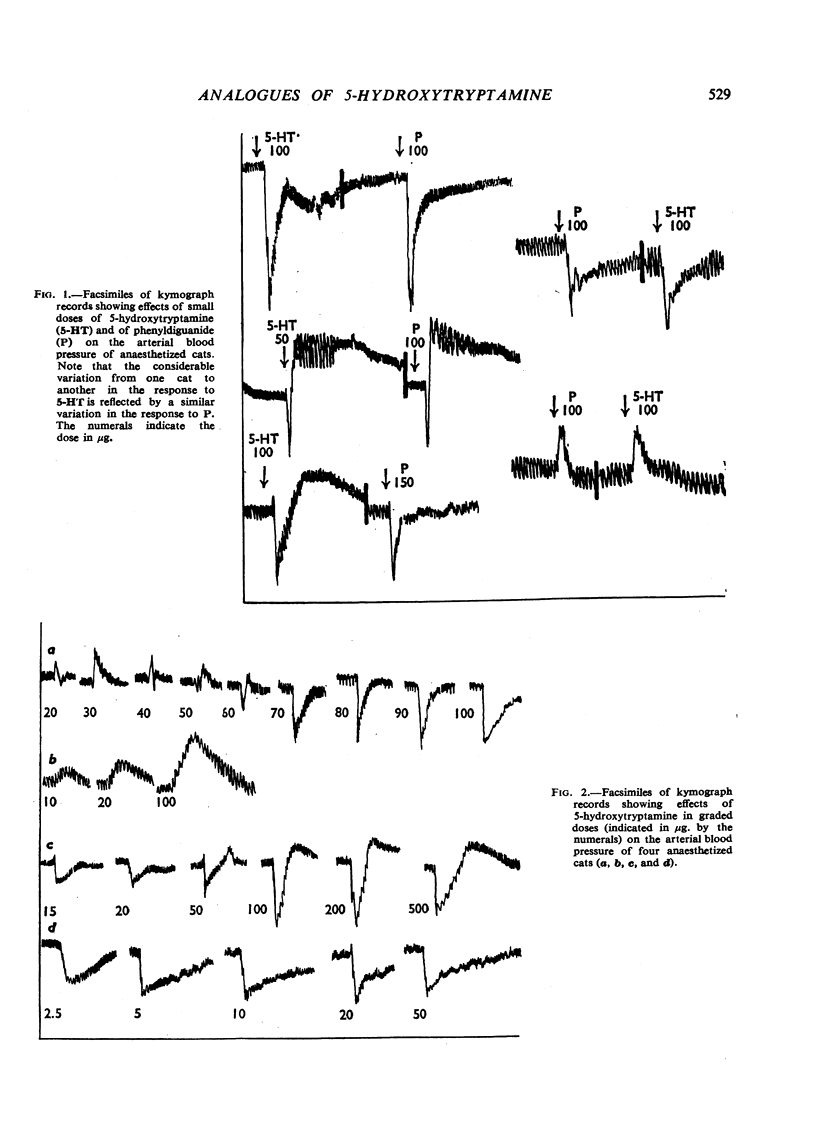


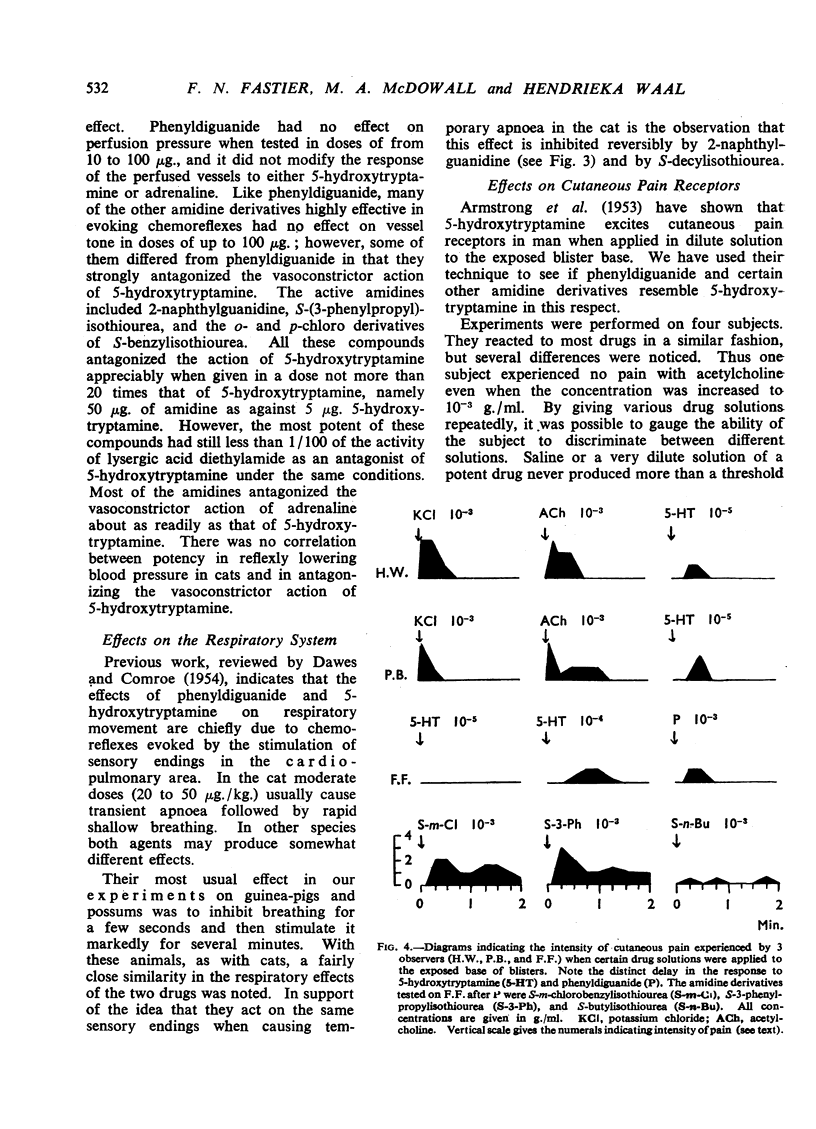
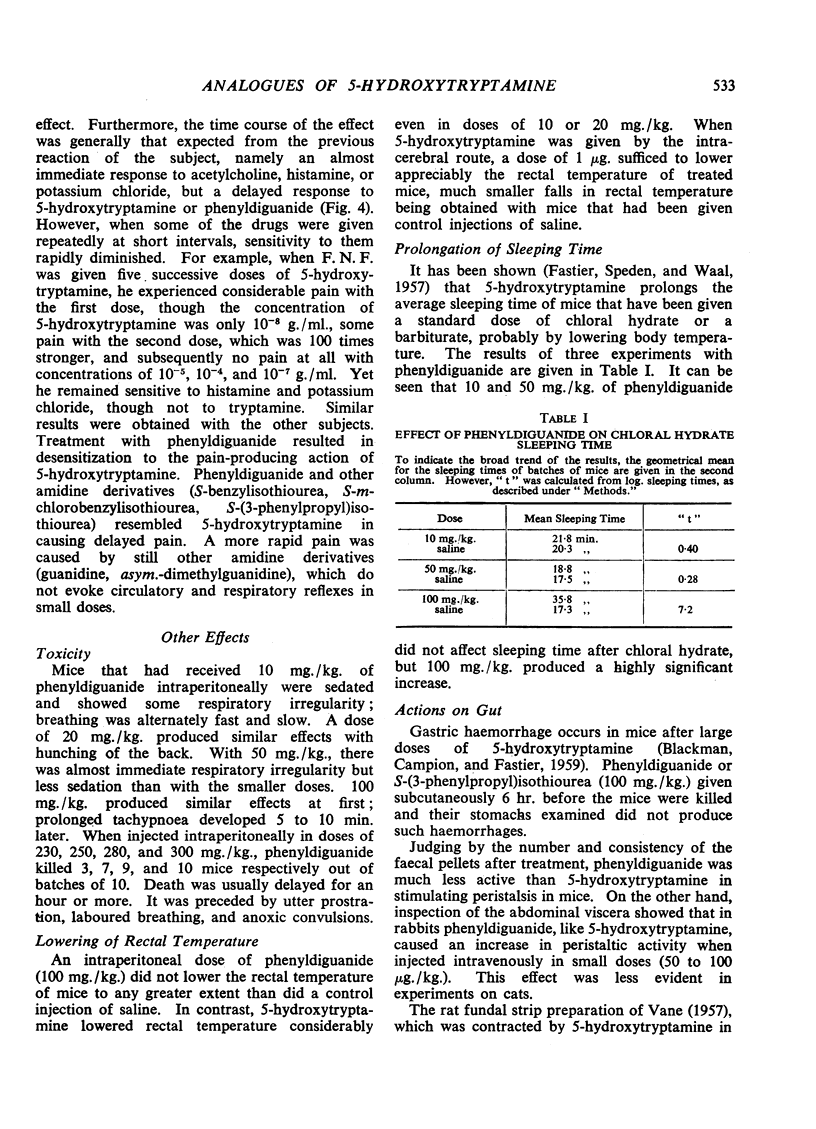
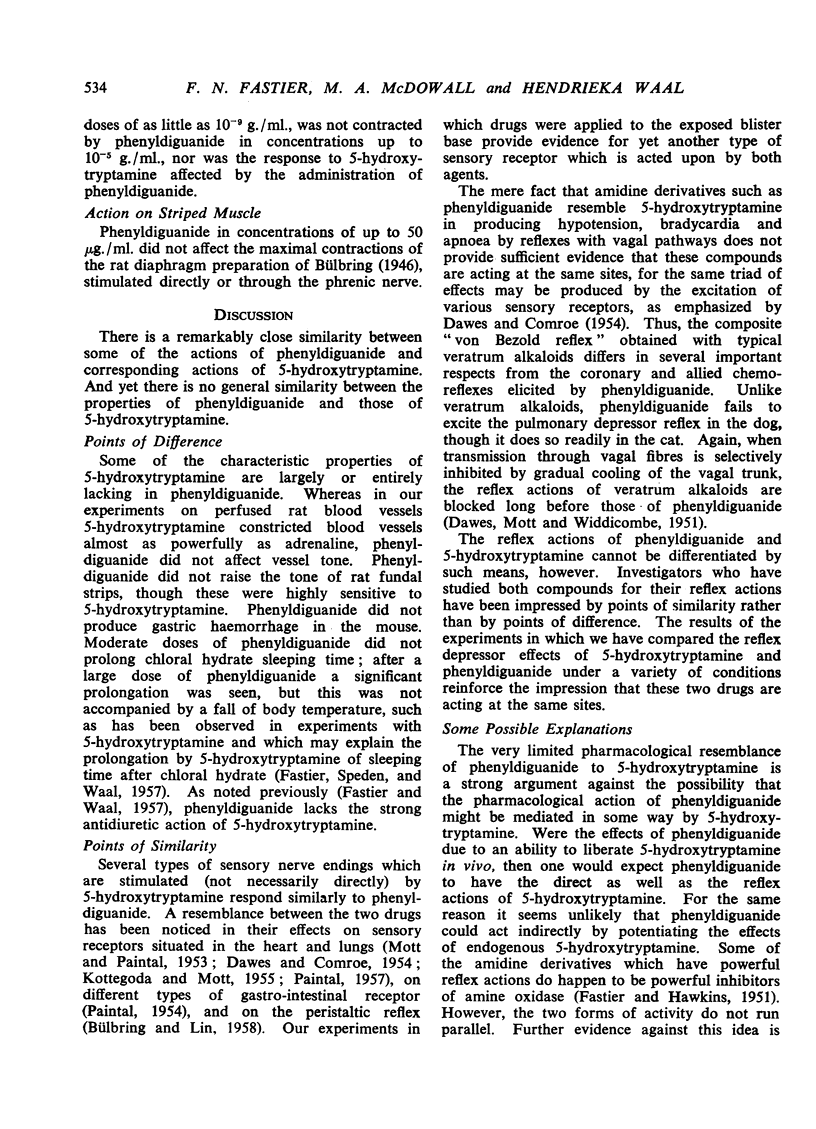
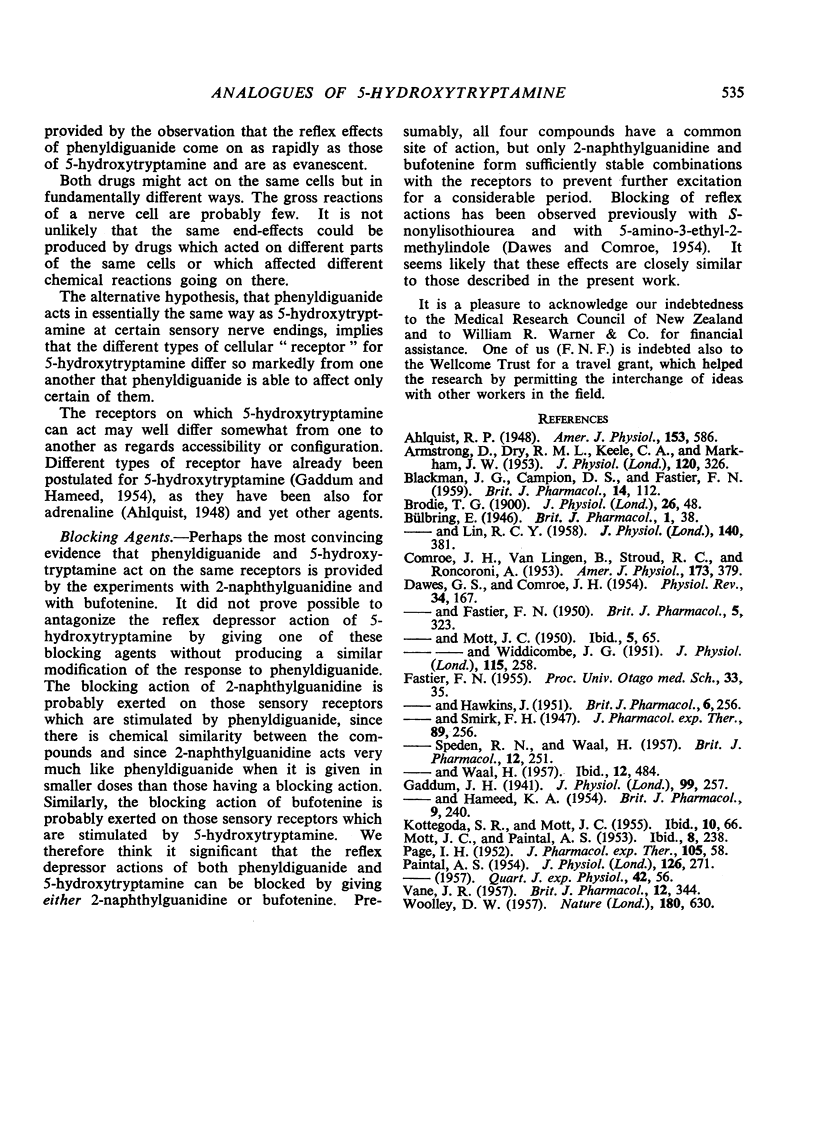
Selected References
These references are in PubMed. This may not be the complete list of references from this article.
- ARMSTRONG D., DRY R. M. L., KEELE C. A., MARKHAM J. W. Observations on chemical excitants of cutaneous pain in man. J Physiol. 1953 May 28;120(3):326–351. doi: 10.1113/jphysiol.1953.sp004898. [DOI] [PMC free article] [PubMed] [Google Scholar]
- BLACKMAN J. G., CAMPION D. S., FASTIER F. N. Mechanism of action of reserpine in producing gastric haemorrhage and erosion in the mouse. Br J Pharmacol Chemother. 1959 Mar;14(1):112–116. doi: 10.1111/j.1476-5381.1959.tb00936.x. [DOI] [PMC free article] [PubMed] [Google Scholar]
- Brodie T. G. The immediate action of an intravenous injection of blood-serum. J Physiol. 1900 Dec 31;26(1-2):48–71. doi: 10.1113/jphysiol.1900.sp000821. [DOI] [PMC free article] [PubMed] [Google Scholar]
- COMROE J. H., Jr, VAN LINGEN B., STROUD R. C., RONCORONI A. Reflex and direct cardiopulmonary effects of 5-OH-tryptamine (serotonin); their possible role in pulmonary embolism and coronary thrombosis. Am J Physiol. 1953 Jun;173(3):379–386. doi: 10.1152/ajplegacy.1953.173.3.379. [DOI] [PubMed] [Google Scholar]
- DAWES G. S., COMROE J. H., Jr Chemoreflexes from the heart and lungs. Physiol Rev. 1954 Apr;34(2):167–201. doi: 10.1152/physrev.1954.34.2.167. [DOI] [PubMed] [Google Scholar]
- DAWES G. S., MOTT J. C., WIDDICOMBE J. G. Respiratory and cardiovascular reflexes from the heart and lungs. J Physiol. 1951 Nov 28;115(3):258–291. doi: 10.1113/jphysiol.1951.sp004670. [DOI] [PMC free article] [PubMed] [Google Scholar]
- FASTIER F. N., SPEDEN R. N., WAAL H. Prolongation of chloral hydrate sleeping time by 5-hydroxytryptamine and by certain other drugs. Br J Pharmacol Chemother. 1957 Jun;12(2):251–256. doi: 10.1111/j.1476-5381.1957.tb00129.x. [DOI] [PMC free article] [PubMed] [Google Scholar]
- GADDUM J. H., HAMEED K. A. Drugs which antagonize 5-hydroxytryptamine. Br J Pharmacol Chemother. 1954 Jun;9(2):240–248. doi: 10.1111/j.1476-5381.1954.tb00848.x. [DOI] [PMC free article] [PubMed] [Google Scholar]
- Gaddum J. H. A method of recording the respiration. J Physiol. 1941 Jan 14;99(2):257–264. doi: 10.1113/jphysiol.1941.sp003899. [DOI] [PMC free article] [PubMed] [Google Scholar]
- KOTTEGODA S. R., MOTT J. C. Cardiovascular and respiratory actions of 5-hydroxytryptamine in the cat. Br J Pharmacol Chemother. 1955 Mar;10(1):66–72. doi: 10.1111/j.1476-5381.1955.tb00062.x. [DOI] [PMC free article] [PubMed] [Google Scholar]
- MOTT J. C., PAINTAL A. S. The action of 5-hydroxytryptamine on pulmonary and cardiovascular vagal afferent fibres and its reflex respiratory effects. Br J Pharmacol Chemother. 1953 Jun;8(2):238–241. doi: 10.1111/j.1476-5381.1953.tb00786.x. [DOI] [PMC free article] [PubMed] [Google Scholar]
- PAINTAL A. S. The response of gastric stretch receptors and certain other abdominal and thoracic vagal receptors to some drugs. J Physiol. 1954 Nov 29;126(2):271–285. doi: 10.1113/jphysiol.1954.sp005208. [DOI] [PMC free article] [PubMed] [Google Scholar]
- WOOLLEY D. W. Probable evolutionary relationship of serotonin and indoleacetic acid, and some practical consequences therefrom. Nature. 1957 Sep 28;180(4587):630–633. doi: 10.1038/180630a0. [DOI] [PubMed] [Google Scholar]


